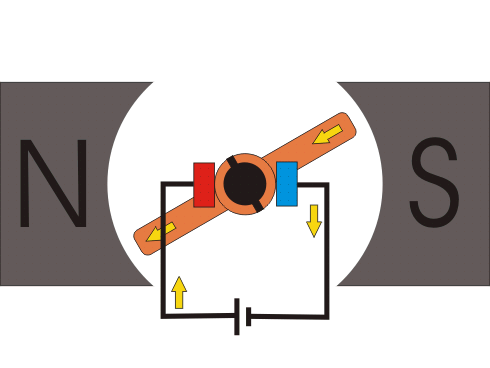A DC motor is an essential device that converts direct current (DC) electrical energy into mechanical motion. It plays a crucial role in various applications by transforming electrical energy into useful mechanical work, making it a key component in many machines and systems. This article explores the working principles, types, losses, and speed control methods of DC motors, providing a comprehensive understanding of their operation and significance.
Table of Contents
What is a DC Motor?
A DC motor is a device that converts direct current (DC) electrical energy into mechanical energy. The structure of a DC generator and a DC motor is the same.
How Does a DC Motor Work?

When a DC motor is supplied with electrical power, the flux within it moves from the north pole to the south pole, and the current generated moves towards the north pole. According to Fleming’s left-hand rule, it rotates in a counterclockwise direction.

Types of DC Motors
DC motors can be categorized into three types based on the connection between the field and the armature:
- Shunt Motor, Eb = V – IaRa
- Series Motor, Eb = V – Ia(Ra+Rsc)
- Compound Motor
Compound motors can further be divided into two types:
- Long Shunt Compound Motor, Eb = V – IaRa – IscRsc
- Short Shunt Compound Motor, Eb = V – Ia(Ra+Rsc)
Losses in DC Motors
- Copper Loss
- Core Loss
- Friction Loss
- Air Loss
Description of Losses
Copper Loss
- Armature Copper Loss = I2aRa
Field Copper Loss
- Shunt Field Loss
- Series Field Loss
Brush Contact Resistance Loss
- Magnetic Loss or Core Loss
- Hysteresis Loss
- Eddy Current Loss
Mechanical Loss
- Friction Loss
- Air Friction Loss
Other types of losses include:
- Stray Loss = Magnetic + Mechanical
- Constant Loss = Shunt Field + Stray
- Variable Loss = I2aRa
- Total Loss = Variable + Constant
What is Shaft Torque in DC Motors?
The torque obtained at the armature of the motor is not considered as shaft torque because some torque is lost in the iron and bearing parts of the motor. Therefore, the torque available for doing work is called shaft torque.
What is Back EMF in DC Motors?
When the armature of a DC motor rotates within the magnetic field of the field windings, it cuts the magnetic lines of force, inducing a voltage in the armature conductors. This induced voltage is opposite in direction to the supply voltage and is known as Back EMF.
Power Stages of DC Motors
⇒ Motor Power Input ⇒ Copper Loss ⇒ Mechanical Power Developed ⇒ Iron and Friction Loss ⇒ Motor Output Power
How to Control the Speed of DC Motors?
- By varying the voltage
- By series-parallel control
- By changing the magnetic flux
- By adjusting the resistance in the armature circuit
What is Speed Regulation in DC Motors?
Speed regulation is defined as the percentage difference between the no-load speed and the full-load speed, divided by the full-load speed.
Speed Regulation = (No Load Speed – Full Load Speed) * 100 / Full Load Speed
1. What is a DC Motor?
- A DC motor is a device that converts direct current (DC) electrical energy into mechanical energy. It is structurally similar to a DC generator.
2. How does a DC Motor work?
- A DC motor works by supplying electrical power, which creates flux that moves from the north pole to the south pole, causing the current to flow toward the north pole. According to Fleming’s left-hand rule, this interaction results in the motor rotating counterclockwise.
3. What are the different types of DC Motors?
- DC motors can be classified into three types based on the connection between the field and the armature:
- Shunt Motor
- Series Motor
- Compound Motor (which can be further divided into Long Shunt and Short Shunt Compound Motors)
4. What are the common losses in a DC Motor?
- The common losses in a DC motor include:
- Copper Loss
- Core Loss
- Friction Loss
- Air Loss
5. What is Shaft Torque in a DC Motor?
- Shaft torque is the effective torque available for doing work in a DC motor after accounting for losses in the iron and bearing parts of the motor.
6. What is Back EMF in a DC Motor?
- Back EMF (Electromotive Force) is the voltage induced in the armature of a DC motor that opposes the supply voltage. It is generated when the armature rotates within the magnetic field of the motor’s field windings.
7. How can the speed of a DC Motor be controlled?
- The speed of a DC motor can be controlled by:
- Varying the voltage
- Series-parallel control
- Changing the magnetic flux
- Adjusting the resistance in the armature circuit
8. What is Speed Regulation in a DC Motor?
- Speed regulation is the percentage difference between the no-load speed and the full-load speed, divided by the full-load speed. It indicates how well the motor maintains its speed under varying load conditions.
What is a DC Motor?
A DC motor is a device that converts direct current (DC) electrical energy into mechanical energy. It shares the same construction as a DC generator.
How Does a DC Motor Work?
When electrical supply is given to a DC motor, magnetic flux moves from the north pole to the south pole, causing the motor to rotate in a direction determined by Fleming’s left-hand rule.
What Are the Main Types of DC Motors?
DC motors are classified into three types based on how the field winding is connected to the armature: Shunt Motor, Series Motor, and Compound Motor (which is further divided into Long Shunt and Short Shunt Compound Motors).
What Are the Different Losses in a DC Motor?
The losses in a DC motor include copper losses, core losses (magnetic losses like hysteresis and eddy current losses), friction losses, and stray losses.
How is the Speed of a DC Motor Controlled?
The speed of a DC motor can be controlled by varying the voltage, using series-parallel control, changing the magnetic flux, or adjusting the resistance in the armature circuit.



